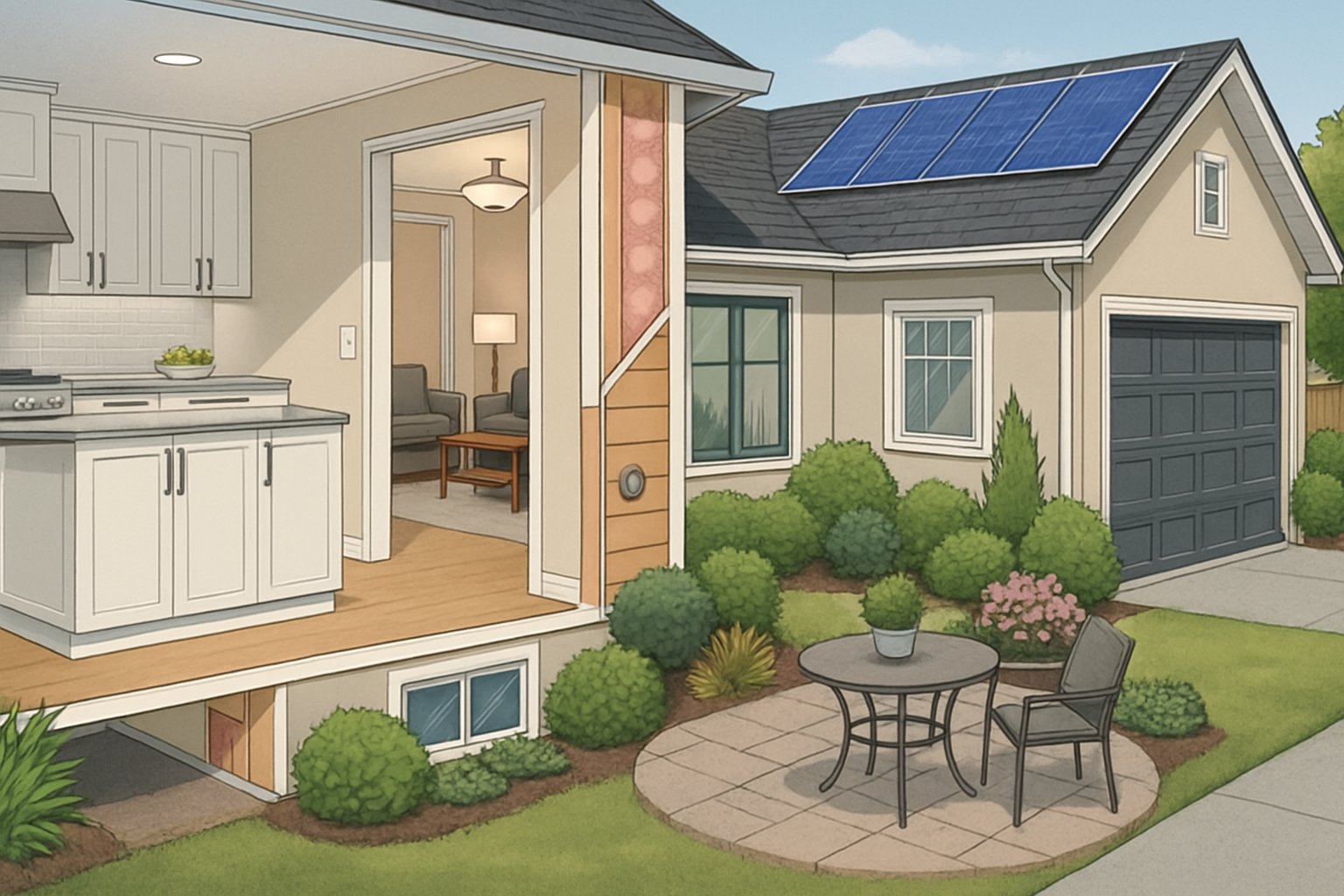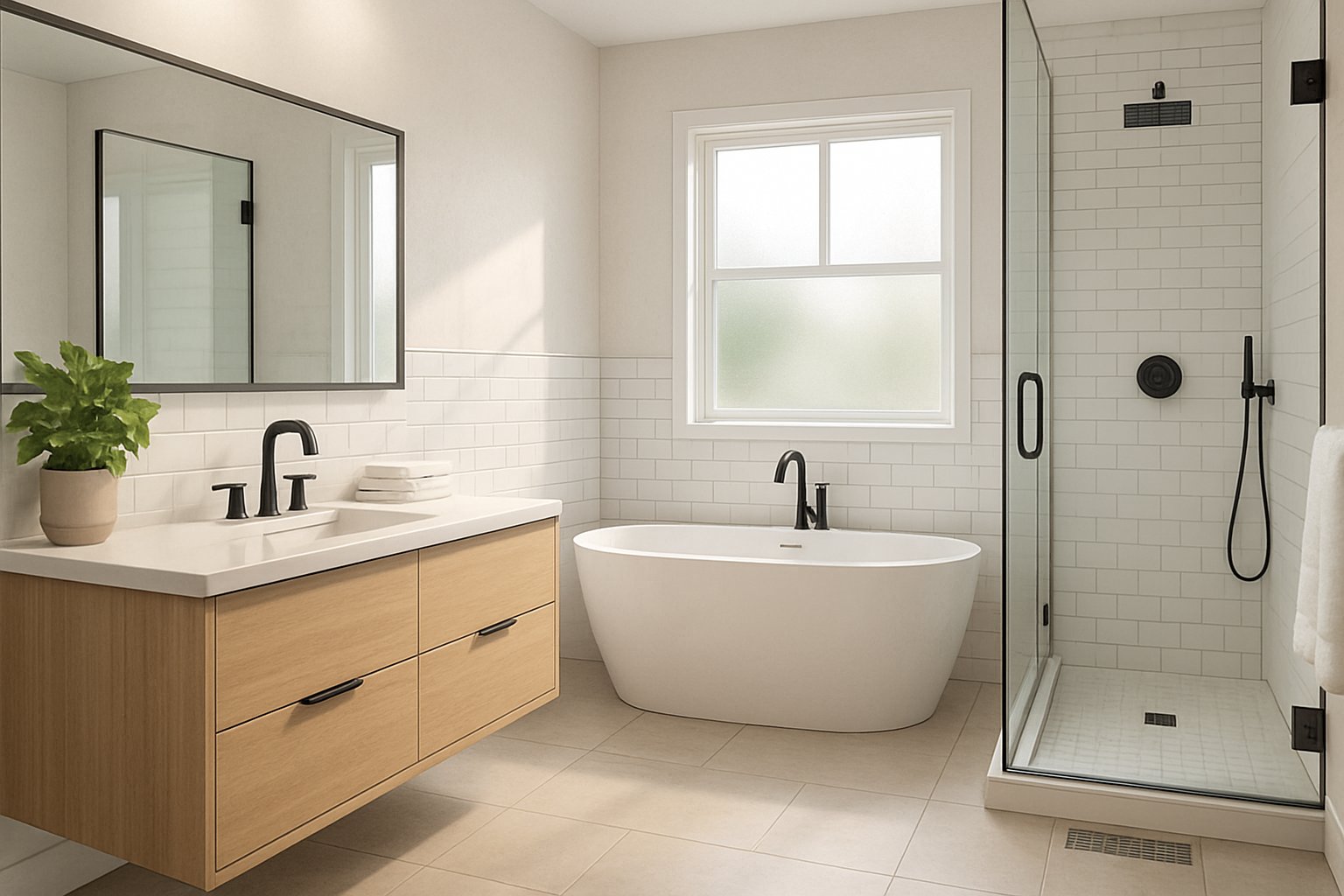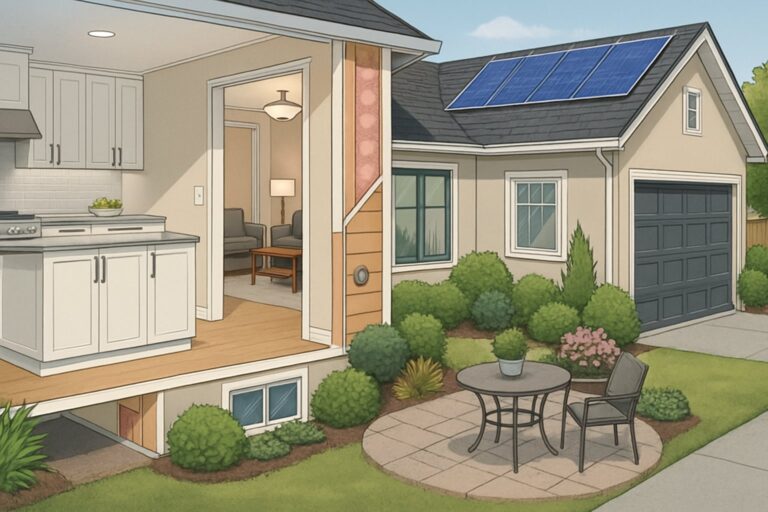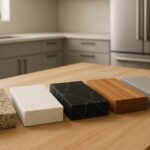Making smart upgrades can bump up your home’s value for years. Most folks want to enjoy their living space and get a nice return if they ever sell.
The right home improvements can give you both—better daily comfort and a solid investment.

Not every renovation makes the same impact. Some projects just pay off more than others, plain and simple.
If you’re smart, you’ll pick upgrades that boost both function and appeal—think kitchens, energy efficiency, outdoor spaces, and floors that actually look good.
Need a Home Fix – Emergency or Routine?
From leaks and no-heat nights to simple tune-ups, our 24/7 hotline connects you with trusted local pros in minutes.
1) Kitchen remodel with modern appliances
Remodeling the kitchen, especially with modern appliances, is usually a top way to get your money’s worth. The kitchen’s the heart of the home and buyers always notice it first.
Energy-efficient, up-to-date appliances catch the eye. People shop for homes with kitchens that feel fresh and practical.
A minor remodel can pay back about 70% of what you spend. That’s a pretty good deal if you might sell soon.
It’s smart to swap out old appliances for energy-saving ones. A new fridge or range can make the whole room feel more current.
It’s easy to go overboard with luxury gadgets, but most buyers don’t care about built-in espresso machines or fancy ice makers. Stick to practical upgrades.
Focus on making the kitchen both useful and attractive. Pair those appliances with new countertops or hardware for the biggest wow factor.
After a kitchen remodel, 84% of homeowners say they’re happier at home. That’s a win, even before you think about resale.
2) Energy-efficient window replacement
Old windows suck up energy and waste money. The Department of Energy says windows can cause up to 30% of heating and cooling loss.
Switching to energy-efficient windows brings down utility bills. They use better insulation and materials that keep your place comfy all year.
Buyers love seeing new, efficient windows. They know they’ll save on energy costs right away.
Look for NFRC ratings—they tell you how well a window insulates and controls heat.
Get a pro to install them. Bad installation means leaks and less efficiency.
Good windows last decades and don’t need much upkeep. That’s why they’re a smart investment.
You might even qualify for tax breaks when you upgrade. Those help soften the upfront blow.
If you’re on a budget, window films can improve existing windows’ performance without a full replacement.
Besides saving energy, new windows get rid of drafts and keep every room feeling just right.
3) Updated bathroom with new fixtures

Bathroom upgrades nearly always give you a solid return. Swapping out old fixtures can totally change the vibe without a gut job.
New faucets are an easy win—chrome, matte black, or brushed nickel look sharp and modern.
Lighting matters too. Good LED vanity lights save energy and make the space more usable.
Water-saving toilets grab the attention of eco-minded buyers. Dual-flush models look good and keep the water bill down.
Match your shower and tub fixtures to the style you’re going for. Rain shower heads or handhelds add a bit of luxury without big changes.
Don’t forget the details—drawer pulls and hinges bring the whole look together.
Some folks love smart fixtures with sensors or digital controls, but reliable traditional options still have their fans.
Choose quality fixtures—they’ll last longer and keep looking good. It’s worth spending a little more for that.
Pick updates that fit your bathroom’s layout and actually make the space work better.
4) Curb appeal enhancement with landscaping
Landscaping can bump your home’s value up by as much as 15%. First impressions matter, and a tidy yard draws in buyers fast.
Simple projects go a long way. Plant some flowers, trim the bushes, and keep the walkways clean—it doesn’t have to be complicated.
Put plants where they make sense. Trees add shade and frame the house, while shrubs make neat borders.
Outdoor lighting shows off your yard after dark. Solar lights are cheap and easy to install.
Fresh mulch and clean edging make flower beds look sharp. It’s a quick weekend job with big payoff.
Water features like fountains can add a special touch, but keep maintenance in mind. Nobody wants a headache.
Homes with great landscaping can sell for up to 7% more. You don’t need fancy equipment—just a little effort and some basic tools.
5) Adding a smart thermostat system
Installing a smart thermostat can make your home more appealing and energy efficient. You can control the temperature from your phone, which buyers love.
These gadgets help you save on utility bills by learning your schedule and adjusting automatically. It’s a small upgrade with a big impact.
Modern buyers want smart features that actually help. A smart thermostat fits the bill—convenience and savings in one package.
They’re pretty affordable and usually easy to install. Most folks can handle it themselves without calling in an electrician.
Energy savings attract eco-conscious buyers. Many models even show you detailed energy reports so you can track usage.
You can control them with your voice or an app, which feels pretty futuristic. No need to tear up walls or do a major renovation.
6) Installing hardwood flooring
Hardwood floors never really go out of style. They’re a classic upgrade that most buyers appreciate.
On average, new hardwood floors can bump your home’s value by about $6,500. Some realtors say you might even get back more than you spent.
People look for hardwood when they’re house hunting. It’s easy to keep clean and lasts forever if you take care of it.
You can pick solid hardwood or engineered. Solid is best for the long haul and can be refinished a bunch of times.
Popular choices include oak, maple, walnut, and cherry. Each one brings its own vibe and durability.
Installation takes a few days, and pros usually do it better. A good fit and finish really matter for resale.
Hardwood works in most rooms except bathrooms and basements. Throw down an area rug for extra style.
This upgrade just adds warmth and character that carpet can’t match. It’s hard to go wrong here.
7) Finished basement renovation
Finishing your basement adds usable space and boosts value. You can usually get back 70-75% of what you spend if you sell.
There’s a lot you can do with a basement—family room, office, gym, or guest bedroom. The trick is making it feel comfortable and livable.
Start by handling any moisture issues. Good insulation and lighting make a big difference down there.
Adding finished square footage appeals to buyers who need more room. More space means more options for families or hobbies.
Focus on quality materials and solid work. Sloppy jobs can actually hurt your home’s value.
If you’re starting from scratch, you can design the space for your needs and meet current codes. That’s a real advantage.
Plus, you get to enjoy the extra space right away. It’s not just about resale—it’s about living better now.
8) Outdoor deck or patio addition
Decks and patios create outdoor living space that buyers love. They make your home feel bigger and give you a place to hang out or entertain.
Decks can return about 63–66% of their cost. Wood decks look great but need regular upkeep. Composite decks cost more but are low maintenance.
Patios are usually cheaper to build and work in most yards. You’ve got options like concrete, stone, or pavers.
Attached spaces add more value because they connect right to the house. Easy access makes them more usable.
Pick what fits your home and climate. Either way, these upgrades turn a boring backyard into a real asset.
They’re popular because you get to enjoy them now and they pay off later. It’s a win-win for most homeowners.
9) Fresh exterior paint
Painting your home’s exterior is one of the cheapest ways to add value. A fresh coat can boost your property’s worth by 2–5% for not much cash.
It makes your house stand out instantly. First impressions count, and paint sets the tone before buyers even walk in.
Paint protects your siding and trim while making everything look cared for. Buyers see fresh paint and assume the house is well maintained.
Stick with neutral colors—whites, grays, or beiges appeal to the most people. Bright or unusual colors can scare buyers away.
Prep work matters. Clean, scrape, and prime before painting for results that last. Quality paint costs more but holds up better.
Most homes take three to seven days to paint, depending on size and the weather. If you’re handy, you can probably handle it yourself with a little patience.
10) Open floor plan redesign
Opening up your floor plan is one of the best ways to bump up your home’s value. Knocking down walls between rooms gives you those big, airy spaces everyone seems to want these days.
Expect to pay somewhere between $10 and $25 per square foot for this kind of renovation. You’ll probably get back about half of what you spend when it’s time to sell—sometimes more if you’re lucky or in a hot market.
These open layouts connect kitchens, dining rooms, and living areas into one flowing space. They just feel bigger and brighter than those old-school, closed-off rooms.
If you’re the kind of person who likes to cook and chat with family or friends at the same time, this design is a dream. Entertaining gets a whole lot easier too.
Even if you don’t add actual square footage, the space feels more usable. No more squeezing through tiny doorways or feeling boxed in.
Older homes with lots of small, separate rooms can feel pretty dated. Buyers today usually want something more open and flexible.
Don’t just start swinging a sledgehammer, though. You need a contractor who knows which walls are holding up the house.
Open floor plans work especially well for people who work from home or need rooms to do double duty. You can turn a corner of the living room into an office—or a play area—without feeling cramped.
Factors That Influence Lasting Home Value
If you want your improvements to pay off, it’s smart to focus on what buyers in your area actually want. Location, materials, and energy efficiency all play a big part in whether your home’s value keeps rising.
Neighborhood and Market Trends
Let’s be honest—location is everything. Homes near good schools, low crime, and jobs almost always do better than those that aren’t.
Trends come and go. Right now, buyers seem to love mid-tone gray kitchens and neutral colors more than bold design choices.
Key neighborhood factors that boost value:
- School district ratings
- Crime statistics
- Public transportation access
- Shopping and dining options
- Future development plans
Most buyers dig into these details before they make an offer. If your neighborhood has a new transit line or business center coming, that can really push up values fast.
Real estate markets aren’t all the same. What works in the city might flop in a rural area, so check out what’s popular nearby before you remodel.
Quality of Materials
People can spot cheap finishes from a mile away. High-quality materials last longer and need less fixing, which buyers definitely notice.
Materials that add long-term value:
- Hardwood flooring instead of laminate
- Natural stone countertops
- Quality paint that resists fading
- Solid wood cabinets with soft-close hardware
- Metal roofing or architectural shingles
Good paint isn’t just for looks—it keeps your walls looking fresh and cuts down on touch-ups. It’s a small upgrade that makes a big difference.
Kitchens and bathrooms get the most scrutiny. Durable counters and cabinets in these rooms can justify a higher asking price.
When you buy quality, you often get a warranty, which is a nice bonus for you and whoever buys your house next.
Energy Efficiency Improvements
Energy-efficient homes are just cheaper to run. Buyers know this, and many will pay more for those features.
Top energy efficiency upgrades:
- LED lighting throughout the home
- Programmable or smart thermostats
- Energy-efficient windows and doors
- Improved insulation in attics and basements
- High-efficiency HVAC systems
Solar panels can be a big win in some places, but the payoff depends a lot on your local utility rates and incentives.
Most buyers expect at least some energy-efficient features now. If your house doesn’t have them, you might have to lower your price.
Better insulation and efficient systems mean lower bills every month. That makes your house more affordable, which can help buyers stretch their budgets.
How to Prioritize Your Home Improvement Investments
It’s tempting to go all-in, but the trick is to pick projects that actually fit your budget and life plans. Set a spending limit and try to think about where you’ll get the most bang for your buck.
Assessing Your Budget
Try not to spend more than 5-10% of your home’s value on any one project. Overspending can make it tough to get your money back later.
Emergency repairs come first. If you’ve got a leaking roof, bad wiring, or structural issues—fix those before you even think about new paint or tile. Protecting your investment is non-negotiable.
Create three budget categories:
- Must-do repairs ($500-$5,000)
- High-impact improvements ($2,000-$15,000)
- Dream upgrades ($10,000+)
Mid-range projects usually pay off the best. For example, a minor kitchen remodel around $15,000 often returns nearly all its cost. Those huge renovations? They rarely pay back more than 70%.
Think about financing. If you can pay cash, that’s ideal—no interest, no headaches. Home equity loans help for bigger jobs, but credit cards should be a last resort for small, quick fixes.
Aligning Upgrades With Future Needs
Life changes, so your home should too. Young families might need more storage or safer spaces, while empty nesters often want low-maintenance and easy-access features.
Look ahead five to seven years. If you’re staying put, personalize away. But if you’re thinking of selling soon, stick to upgrades with broad appeal—think neutral paint and updated fixtures.
Market conditions matter. In a seller’s market, simple updates like fresh paint can give you the best return. In a buyer’s market, you might need to invest more to stand out—maybe a kitchen or bath update.
Location counts. Cold climates? Upgrade your insulation and windows. Hot areas? Focus on cooling systems and maybe a patio or outdoor space.
Don’t forget about future upkeep. Hardwood floors look great but need refinishing now and then. Materials like natural stone need special care, and not all buyers want that hassle.
Frequently Asked Questions
People have a lot of questions about which home improvements are actually worth it. Here are some straight answers about costs, value, and timing that might help you decide what to tackle next.
What specific renovations offer the highest return on investment for homeowners?
Kitchen remodels usually come out on top, especially if you update appliances and fixtures. A minor kitchen update can return 70-80% of what you spend.
Replacing old windows with energy-efficient ones also pays off, often returning 65-75%. Buyers love lower utility bills.
Bathrooms matter too. A mid-range bathroom remodel with new finishes and fixtures often gets you back 60-70% of your investment.
Which low-cost upgrades can significantly enhance the value of a home?
Smart thermostats are a bargain—spend under $300 and you might add $1,000 or more to your home’s value. Tech-savvy buyers especially notice these.
Painting is the classic high-return upgrade. A fresh coat inside can actually return more than you spend—sometimes up to 107%.
Don’t underestimate landscaping. New plants, mulch, and a clean exterior can boost curb appeal and give you a 100-200% return on a small investment.
How much could a kitchen remodel potentially contribute to a home’s resale value?
A minor kitchen remodel in the $15,000-$25,000 range can add $12,000-$20,000 to your home’s value. That’s about a 70-80% return.
Bigger kitchen projects—think $50,000 or more—usually return less, around 50-60%. It depends a lot on your area and the materials you pick.
Modern appliances and energy-efficient upgrades tend to pay off better than just cosmetic changes.
Can energy-efficient upgrades impact the appraisal value of a property?
Energy-efficient windows can bump up your appraisal by 3-5% in many places. Appraisers know these cut long-term costs.
Smart thermostats and similar upgrades also add value. They show buyers your home is cheaper to run.
Many energy upgrades qualify for tax credits or rebates, which sweetens the deal even more.
What are the key factors to consider when budgeting for a home renovation to ensure it adds value?
Stick to spending 10-15% of your home’s value on most projects. Going over that rarely pays off.
Check what’s selling in your area before you start. Local trends make a big difference in what adds value.
Quality and professional installation matter. DIY can be fun, but bad results can actually lower your home’s value.
Which home improvement projects are commonly known to deliver poor returns on investment?
Swimming pools rarely add much value. In fact, they can actually turn some buyers away.
You’ll usually get back just 30-40% of what you spend on a pool.
Home offices and elaborate custom features don’t appeal to most buyers. These specialized spaces just don’t fit everyone’s needs.
High-end luxury upgrades in moderate-priced neighborhoods rarely pay off. The improvement should really match the area’s overall value.







Leave a Reply